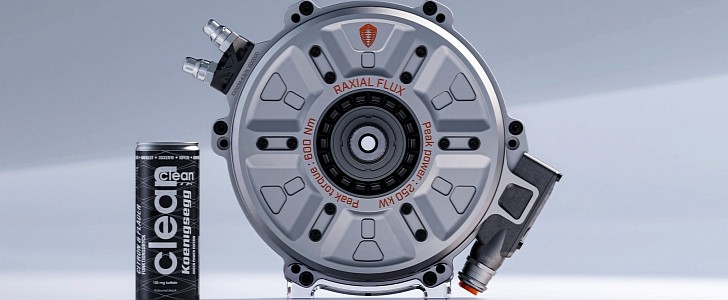Great leaps in technology are often so simple that competitors wonder: why didn’t I think of that? This is pretty much what happened with the Quark motor developed by Koenigsegg. Being compact is just part of its appeal. Few have paid attention to the “raxial” flux it offers. However, autoevolution asked how the company did that, and the explanation is so simple it almost hurts.
Koenigsegg starts by reminding us that any topology suffers from magnetic flux leakage. This phenomenon is responsible for the few losses these highly efficient machines present. The radial-flux motor has more power but less torque and the axial-flux unit works the other way around: it offers plenty of torque but with less power. That’s why radial motors are more common in high-performance electric cars such as the Rimac C_Two and the Pininfarina Battista.
If you look at the Quark, you instantly notice that it is an axial-flux motor due to its shape. The fact that it is in a hypercar – the Gemera – shows that Koenigsegg is pretty confident that it will provide the power it needs.
As we mentioned in our previous article, each Quark delivers a peak power of 250 kW (335 hp). To give you a proper basis of comparison, the Koenigsegg Regera uses three electric YASA axial motors: two YASA 750 on the rear axle and a YASA 400 on the front axle. Each YASA 750 weighs 37 kilograms (81.6 pounds) and delivers 800 Nm (590 pound-feet) and 180 kW (241.4 hp), while the YASA 400 weighs 28.2 kg (62.2 lb), provides 350 Nm (258.2 lb-ft) and 160 kW (214.6 hp).
While the Quark offers less torque than the YASA 750, it is almost 20% lighter and way more powerful. Koenigsegg managed to achieve this simply by “increasing rotor diameter against the bulk of the stator and optimizing the stator OD (outer diameter) to be able to accept this extra flux.” Yes, it is that simple.
With this simple measure, the Swedish company managed not only to diminish leakage, but used “this radial flux to augment the main axial flux.” Koenigsegg argues that it may not have invented the idea, only that it has not seen it in use before. What makes the Quark unique is that it was designed “to take maximum profit of the radial flux in an axial-flux motor.”
Again, that shows how the electric car is a work in process. It is very far from the stage in which only minor improvements happen, as we currently see with internal combustion engines. Koenigsegg’s motor is just an excellent example of how much room for innovation EVs still offer.
If you look at the Quark, you instantly notice that it is an axial-flux motor due to its shape. The fact that it is in a hypercar – the Gemera – shows that Koenigsegg is pretty confident that it will provide the power it needs.
As we mentioned in our previous article, each Quark delivers a peak power of 250 kW (335 hp). To give you a proper basis of comparison, the Koenigsegg Regera uses three electric YASA axial motors: two YASA 750 on the rear axle and a YASA 400 on the front axle. Each YASA 750 weighs 37 kilograms (81.6 pounds) and delivers 800 Nm (590 pound-feet) and 180 kW (241.4 hp), while the YASA 400 weighs 28.2 kg (62.2 lb), provides 350 Nm (258.2 lb-ft) and 160 kW (214.6 hp).
While the Quark offers less torque than the YASA 750, it is almost 20% lighter and way more powerful. Koenigsegg managed to achieve this simply by “increasing rotor diameter against the bulk of the stator and optimizing the stator OD (outer diameter) to be able to accept this extra flux.” Yes, it is that simple.
With this simple measure, the Swedish company managed not only to diminish leakage, but used “this radial flux to augment the main axial flux.” Koenigsegg argues that it may not have invented the idea, only that it has not seen it in use before. What makes the Quark unique is that it was designed “to take maximum profit of the radial flux in an axial-flux motor.”
Again, that shows how the electric car is a work in process. It is very far from the stage in which only minor improvements happen, as we currently see with internal combustion engines. Koenigsegg’s motor is just an excellent example of how much room for innovation EVs still offer.






